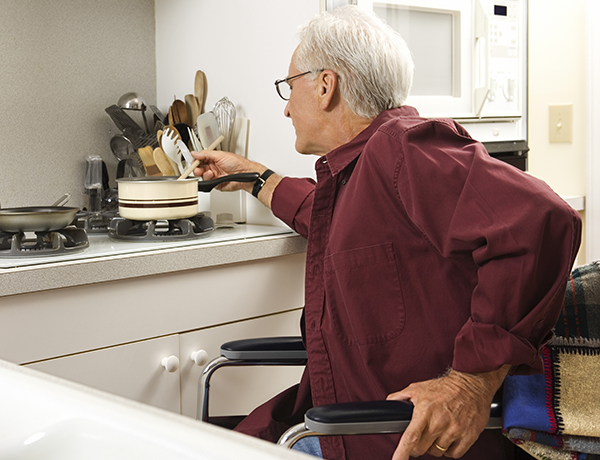 The kitchen and bathroom rank among the most hazardous rooms of the home, yet they are essential to daily life — thus, when considering modifications for yourself or your loved one, these key areas deserve the utmost attention. The following suggestions are just some of the options available. With a better understanding of possible home risks and adjustments, as well as the guidance of an in-home occupational therapist, you can drastically improve not only your loved one’s safety from falls or other injuries, but also his or her independence and quality of life.
The kitchen and bathroom rank among the most hazardous rooms of the home, yet they are essential to daily life — thus, when considering modifications for yourself or your loved one, these key areas deserve the utmost attention. The following suggestions are just some of the options available. With a better understanding of possible home risks and adjustments, as well as the guidance of an in-home occupational therapist, you can drastically improve not only your loved one’s safety from falls or other injuries, but also his or her independence and quality of life.
Bathroom modifications
With respect to bathroom modifications, the key concern is safety. A study by the CDC found that people over the age of 85 experience the highest rate of bathroom-related injuries of any age group; more than half of these injuries occur when using the toilet. One simple modification to address this problem is installing grab bars on either side of the toilet. Grab bars must be sturdy enough to support your loved one’s body weight; additional reinforcement may be necessary for larger individuals. For extra stability while getting on and off the toilet, consider ‘sheltering arm’ grab bars, which mount to the sides of the toilet and the floor.
The shower and bathtub, which by their nature become dangerously slick and slippery, can also be made safer, thanks to a wide variety of adaptive equipment designed for safer and easier bathing. Shower chairs can help bathers who have poor balance or are unable to stand, while hand-held shower systems bring the water source down to a comfortable and easy-to-use level. Additionally, anti-slip decals can be placed both in the shower and on the bathroom floor to reduce fall risks. This is a great alternative to traditional bathroom floor mats, which can actually increase this hazard.
Kitchen modifications
In the kitchen, although safety remains a priority, the adaptive equipment available tends to focus on ease of use. For wheelchair accessibility, doorways need to be widened, carpets should be replaced with linoleum or tile flooring, and the kitchen should have a 5-foot by 5-foot turning radius. Cabinet doors can be removed (or even the cabinets themselves can be removed or modified) to provide additional leg room while using counters from a seated position; at the same time, countertops can be lowered for even better accessibility while seated. Conversely, raising the counter height may benefit individuals who stand to prepare and cook meals, but have a hard time bending over. The challenge of carrying or transferring food or other items about the kitchen can be lessened by acquiring a simple rolling utility cart.
New appliances may also make things easier for your loved one, depending on his or her specific needs. Accessible options include refrigerators with bottom freezers, slopping sinks, and stoves with controls on the front rather than the rear or side. Strategically installed mirrors above the stove can allow a seated user to better monitor what’s cooking. For individuals who have difficulty using a conventional oven or stove, toaster ovens and microwaves may be more user-friendly alternatives.
Expert assessment
For best results in home modification and implementing adaptive equipment, you may want to seek out an in-home occupational therapist for a home assessment. This evaluation will determine your loved one’s personal needs with respect to individual health status and ability to perform basic tasks. Your in-home occupational therapist will work with your loved one to assess the following:
- Balance
- Coordination
- Strength
- Attention
- Vision
- Communication
Based on these characteristics, the occupational therapist can identify specific problem areas in your loved one’s home and make expert suggestions. Importantly, this advice should include not only what adaptive equipment would be most useful to your loved one, but how to install and use it correctly. A thorough home assessment can reveal dangers you might not have thought of, as well as a host of suggestions for safer arrangements and procedures throughout your loved one’s living space.
To determine whether you or your loved one might benefit from in-home occupational therapy or other home care services from Residential Home Health, contact us to discuss your specific situation with a Home Care Specialist today.

